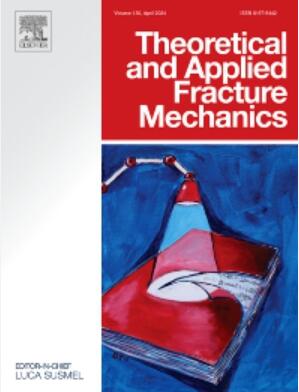基于双层位周动力的复杂动态裂缝变分损伤建模
IF 5.6
2区 工程技术
Q1 ENGINEERING, MECHANICAL
引用次数: 0
摘要
在非一般基于状态的周动力学中,剪切键断裂模拟可能存在数值不稳定性。为了解决这一问题,我们建立了弹性固体脆性断裂动态建模的含变分损伤双水平周动力学模型。在不明确使用损伤变量的情况下,损伤场是应变能场的自然结果或后处理。由于消除了粘结切割过程,大大增强了断裂扩展的数值稳定性。与在整个模拟过程中跟踪每个键的损伤状态的周动力学不同,变分损伤模型使用标量损伤变量来表示每个材料点的状态。该模型利用应变张量的谱分解,将损伤表示为“正”应变能密度的函数。这种分解方案有效地防止了裂纹闭合时裂纹表面的互渗,保证了物理上一致的断裂行为。给出了该方法的数值实现流程图。我们通过模拟受拉伸/剪切边界条件影响的缺口板来证明当前方法的能力。二维和三维的Winkler实验和破碎模拟。本文章由计算机程序翻译,如有差异,请以英文原文为准。
Dual-horizon peridynamics-based variational damage modeling for complex dynamic fractures
Fracture simulation by cutting bonds in non-ordinary state-based peridynamics may suffer from numerical instability. To solve this problem, we develop a dual-horizon peridynamics equipped with variational damage for the dynamic brittle fracture modeling in elastic solid. Without using damage variables explicitly, the damage field is a natural outcome or a post-processing of the strain energy field. Since the bond-cutting process is removed, the numerical stability of fracture propagation is greatly enhanced. Unlike peridynamics, which tracks the damage state of each bond throughout the simulation, the variational damage model employs a scalar damage variable to represent the state of each material point. This model expresses damage as a function of the “positive” strain energy density, utilizing the spectral decomposition of the strain tensor. Such a decomposition scheme effectively prevents crack surface interpenetration when the crack closes, ensuring physically consistent fracture behavior. A flowchart outlining the numerical implementation of this approach is presented. We demonstrate the capabilities of the current method by simulating a notched plate subjected to tensile/shear boundary conditions, the Kalthoff & Winkler experiment and fragmentation simulation in two and three dimensions.
求助全文
通过发布文献求助,成功后即可免费获取论文全文。
去求助
来源期刊

Theoretical and Applied Fracture Mechanics
工程技术-工程:机械
CiteScore
8.40
自引率
18.90%
发文量
435
审稿时长
37 days
期刊介绍:
Theoretical and Applied Fracture Mechanics'' aims & scopes have been re-designed to cover both the theoretical, applied, and numerical aspects associated with those cracking related phenomena taking place, at a micro-, meso-, and macroscopic level, in materials/components/structures of any kind.
The journal aims to cover the cracking/mechanical behaviour of materials/components/structures in those situations involving both time-independent and time-dependent system of external forces/moments (such as, for instance, quasi-static, impulsive, impact, blasting, creep, contact, and fatigue loading). Since, under the above circumstances, the mechanical behaviour of cracked materials/components/structures is also affected by the environmental conditions, the journal would consider also those theoretical/experimental research works investigating the effect of external variables such as, for instance, the effect of corrosive environments as well as of high/low-temperature.
 求助内容:
求助内容: 应助结果提醒方式:
应助结果提醒方式:


